It’s no secret that the wine industry is big business in the Okanagan, but a recent report demonstrates just how big an economic driver the industry has become.
“We’ve known for a while now that wine touring is the largest specific motivator for travel to Penticton & Wine Country, aside from visiting friends and family,” said Tourism Penticton CEO Jessie Campbell. “And those travellers are coming no matter what marketing message we put out there.”
More than 800,000 visitors come to the region as wine tourists each year, accounting for 1,100 full time jobs, $4 million in taxes to government — all coming together for $87 million in direct economic impact and another $52 million in indirect economic impact.
The Okanagan Wine Tourism Industry Economic Impact Report was commissioned by the Okanagan Wine Festivals Society and the B.C. Wine Institute.
Drawing from over 1,000 interviews at wineries and wine festivals, the report builds a picture of the average wine tourist spending about $474 per person, per day, less than half of which is wine-related. Transportation, accommodation and other expenses account for $302 of the daily spending, with a further $97 spent on wine and another $75 spent at winery restaurants.
“These are certainly very impressive numbers considering that across British Columbia we have 217 wineries with the vast majority being small family-run operations that grow over 80 different varieties of grapes on some 9,800 acres,” said Okanagan-Coquihalla MP Dan Albas.
“This study really validates the importance of wine tourism to our local economy … directly yielding increases in the sale of wine, food and accommodation,” said Dr. Blair Baldwin, professor at Okanagan College and one of the authors of the report, along with Stephen Mellows.
The primary destinations are the core cities, allowing tourists to travel out into the surrounding winery regions: Kelowna, West Kelowna and Penticton.
Campbell said Tourism Penticton makes a specific effort to capitalize on the wine tourism potential.
“We are the only destination — certainly within BC — that is using ‘and Wine Country’ within our brand, and we use this consistently to drive awareness not only for Penticton, but the Naramata Bench, Summerland and Okanagan Falls,” she said.
The impact of the wine industry on the economy is not something that happened overnight. The upcoming 33rd annual Fall Wine Festival demonstrates that vintners have been pioneering this growing industry in British Columbia now for over three decades.
The report comes at the end of what some grape growers say is one of the best growing seasons in recent years, with Jackson-Triggs Estate Winery claiming a record-breaking start to the 2013 harvest for their Osoyoos area vineyards, where they began picking on Aug. 27.
A combination of lower-than-normal-levels of rain, combined with the number of growing degree days — days when the temperature is conducive to ripening grapes — contributed to their earlier start.
On the Naramata Bench, Bob Ferguson of Kettle Valley Vineyards wasn’t so ready to declare 2013 the best ever. Ferguson, who began picking in September, said the grapes were a little early, but he had seen earlier years.
One of the earlier wineries on the bench, Ferguson and co-founder Tim Watt have been growing grapes there since the late 1980s. Looking back, he said 1992, 1994 and 1998 were also good years.
“I’m not willing to jinx things by declaring this too good a year,” said Ferguson. “I did that in 2009 and then bad weather brought down the crop.”
Derek Kontkanen, winemaker at Jackson--Triggs, said that besides an early harvest, the good weather should contribute to a quality vintage.
“This is my 10th vintage here and it’s great to see a return to more normal Okanagan--like weather, similar to 2008 and 2009, with a warm and consistent growing season,” said Kontkanen. “The flavour profile of our first varietal to come in, the Sauvignon Blanc, is just what we’re aiming to achieve: grassy, grapefruit and tangerine tropical notes, along with a good balance of sugar and acidity. Now we just need the weather to hold out to the end of October.”
